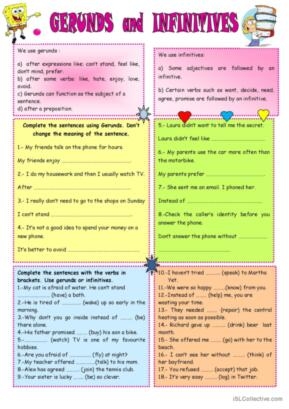Learning the proper use of gerunds and infinitives can be challenging for ESL students. However, with practice and exercises, students can become more comfortable with using these forms in English sentences.
Gerunds are verbs that end in -ing and function as nouns in a sentence. Infinitives, on the other hand, are the base form of a verb with ‘to’ in front of it. Understanding when to use gerunds or infinitives can improve a student’s overall English language skills.
ESL Gerunds and Infinitives Exercises
1. Fill in the blank with the correct form (gerund or infinitive):
a) She enjoys ________ (read) novels in her free time.
b) I need ________ (study) for my upcoming exams.
c) He suggested ________ (go) to the movies this weekend.
2. Rewrite the sentence using a gerund:
a) I want to eat pizza. -> I want ________ pizza.
b) They plan to travel to Europe. -> They plan ________ to Europe.
3. Choose the correct option (gerund or infinitive) to complete the sentence:
a) I like ________ (swim / swimming) in the ocean.
b) He promised ________ (help / helping) me with my project.
4. Fill in the blanks with the appropriate gerund or infinitive:
a) I am looking forward to ________ (visit) my family next month.
b) She avoids ________ (eat) fast food to stay healthy.
5. Complete the sentences with the correct form of the verb:
a) I enjoy ________ (listen) to music in my free time.
b) They decided ________ (take) a trip to the beach this summer.
Practicing these exercises can help ESL students gain a better understanding of when to use gerunds and infinitives in English sentences. With consistent practice, students can improve their grammar and communication skills.
In conclusion, gerunds and infinitives exercises are essential for ESL learners to master these forms of verbs. By practicing and applying these exercises, students can enhance their language proficiency and become more confident in using gerunds and infinitives in their everyday conversations.
